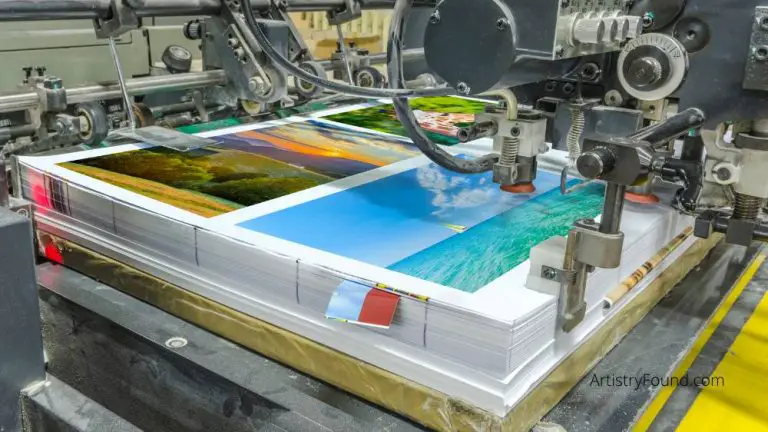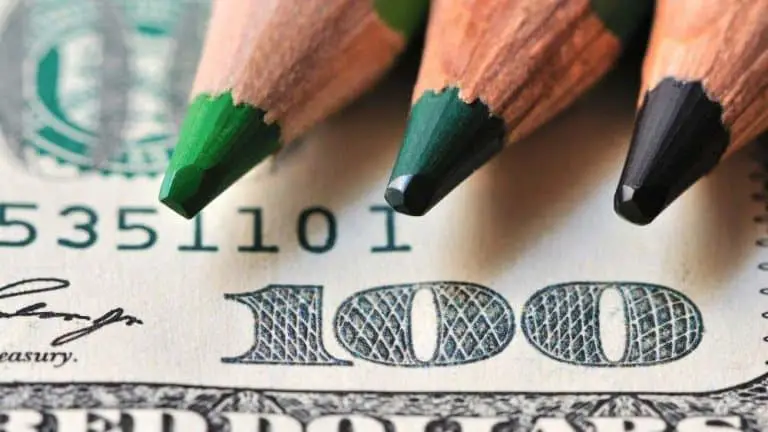The Complete Guide to Making Your Art More Sellable (Attn: Artists)
It can be a daunting task to sell your art. Making a decent living selling original artwork can seem almost impossible. In order to sell your art consistently, you will have to make every effort to distinguish yourself from the competition. Let’s face it, the market is saturated with aspiring artists eager to sell their work. You’ll need to find some ways to stand out from the crowd.
Luckily, there are some things a visual artist can do to turn their artistic hobby into an actual art career. To do that you’ll need to find out how to create sellable art that is in demand by art buyers. The following ideas can help you as an artist begin to sell your artwork on a regular basis, so keep reading to discover the best tips for making your art as sellable as it can be.

(This article may contain affiliate links and I may earn a commission if you make a purchase)
Choose a Medium of Art That Sells Well
Certain mediums sell better than others. That is the plain and simple truth. Artists that want to give themselves the best opportunity to sell their work at a consistent rate should not waste their time with mediums of art that do not sell. The possibilities for art mediums are endless, but the best-selling forms of art will always be the most conventional ones.
Mediums of art that sell the best typically have these qualities:
- The mediums are familiar and not too unconventional
- The subject matter is relatable and pleasant
- The colors used in the art piece are not too busy or loud
- The materials used are not off-putting or disconcerting in any way
- The work of art is able to be set up and displayed very easily
Paintings sell better than any other medium of art does. When people think of an artist, the first image that pops into their mind is a quirky individual wearing a jaunty little beret while they stand and paint at an easel. Throughout history more paintings have been sold than any other kind of artwork in existence. Artists that want to make sellable art should definitely consider painting.
Photography is another huge and booming form of art that sells well. There are tons of possibilities for a shutter-bug to make serious money with the art they make through the lens of their trusty camera. Elements such as lighting, posing, and composition will make all the difference to the artist that wants to pursue the creation of sellable photography.
Sculptures and castings can sell better than you would think. Many retail outlets are happy to purchase large quantities of sculptures or castings that their customers can purchase and display in their homes. Sculptors that build a reputation for themselves can even land well-paying commissions for public works projects like memorials and monuments.
Paintings
Paintings are, by far, the best-sellers in the world of art, but not just any painting is going to net an artist a large sale. You should definitely consider a few extra factors before you consider attempting to sell your paintings. Not all paintings sell well. Only the right combination of painting and subject matter tend to sell consistently well. Artists must keep that in mind.
Here are a few of the best subjects to use when creating paintings that you intend to sell:
- Landscapes that are familiar and generic
- Abstract works that invoke the observer’s feelings and emotions
- Figurative depictions that tell a story of mystique and mystery
- Local architecture, skylines, and culturally significant views
- Seascapes, lighthouses, harbors, and beaches
People tend to choose calming themes that are familiar and do not overly challenge the observer. The paintings that sell consistently are simple and easy to witness. You do not push a story or drive a point home. You simply depict a scene or figure in a way that pleases the observer. Paintings that sell the best are very simple and honest.
Within the category of painting is a trove of media that an artist has to choose from. Of these options, oil, acrylic, and watercolor sell the best. In order for an artist to sell his or her paintings consistently, they need to choose a media that galleries and art-buyers are looking to buy. Other media in paintings can be more costly to frame and maintain.
(Find out what colors in used in paintings sell best in my article here)
Creating sellable paintings does not have to be complicated. By selecting a subject that is not too challenging for the observer and utilizing media that galleries and art-buyers are happy to work with, the artist has already set themselves apart from the thousands of others that failed to do their homework. This can make all the difference for a painter.
Photography
One of the best selling forms of art on the market today is fine art photography. An artist that wants to make their photography more sellable should observe what collectors and buyers are looking for in an artistic photograph. The photos that sell on a regular basis are typically of a similar variety. Artists that want to make their photos more sellable should definitely know what sells.
The characteristics of photos that sell consistently usually include the following:
- Simple subjects that are appropriate for a broad range of display venues
- Landscape photography that is pleasing and uncomplicated
- Images of local places of cultural significance to those who live there
- A balanced level of contrast and light exposure
- The composition is such that it leads the observer’s eye into and through the image
The photographs that sell consistently are not too complicated or busy. An artist that is looking for ways to improve the sale of his or her art should keep things simple. The work should be fundamentally proficient and technically sound. There is no substitute for ability, and a good photograph will reflect the artist’s abilities very clearly and easily.
The subject of a photographic print should be one that the observer can connect with in some way. Niche subjects that are off-putting or unsettling are not going to sell well over a long period. The key to creating photographs that will make for high selling prints depends on the subject, for the most part. This subject should be relatable and easy to observe.
Some artists focus on nature or architecture. There are buyers who would love to add works in these niches to their collection. Places of cultural significance or breath-taking natural landscapes can create some highly sellable art. Photographers that have an eye for the beauty that is around them and the ability to capture it can sell their work quite easily.
Sculptures
This medium of art can sell very well once the artist has identified the interests of the buyers in the market. Typically, sculptures are sold as commissions to municipal buildings, parks, or community recreation centers. Businesses will commission a sculptor to create an ornate entrance area to display their success to clients.
Sculptures can also be sold to individual art buyers directly. These interested buyers are usually decorating their homes with pieces that are easier to display than large, ornate statues. They will purchase original work that is not a distraction in their home, is made from an interesting material, or represents something he or she is very fond of.
Sculptures that sell well are usually made from the following materials:
- Marble
- Granite
- Ceramic
- Plaster
- Porcelain
Top selling sculptures are often depictions of simple subjects that have been crafted by an expert. The importance of the artist’s skill being displayed in a sculpture cannot be understated. A seasoned art collector will know the difference between an artfully crafted piece created by a professional artist, and a cheaply assembled mess. Good artists will know the difference too.
The material that the sculpture is made from can affect its sellability in a big way. Some collectors might only be interested in works that are created using specific materials. Sticking to materials that are commonly used is a good way to ensure that a potential customer will not be steered away from your work. Do not take unnecessary risks.
(Learn how to price sculptures for the best sales in my article here)
Depict Sellable Subjects in Art
This can be the decision point for many art buyers. If the subject of an artist’s work is unrelatable, unsettling, or too provocative, it will be much harder for him or her to find buyers consistently. People who are in the market to purchase art (particularly for their home or office) are not typically searching for something that is revolutionary. People seek familiarity in art subjects.
Subjects that sell well include the following:
- They are relatable to the observer in some way
- They depict an interesting figure that catches the eye
- They showcase a beautiful landscape
- They do not challenge the observer too much
- They help people find peace or comfort
Art that challenges the observer’s mind or eyes too much will be more difficult to sell on a consistent basis. The work that an artist creates to sell should be easy to observe. The work of art should not be made with materials or colors that are overly bold and likely to clash with its surroundings. Sellable works of art are versatile, balanced, and classic.
A work of art that is sellable will be able to display easily. It is important that the art buyer will be able to display their purchase throughout their home. If an artist created a work that was too rich in colors that have the tendency to clash against others, you might have created a situation in which the buyer will have to pass on the purchase.
The subject of a sellable work of art should be relatable to the observer in some way. These connections are for the observer to create, but the artist can definitely shoot themselves in the foot by depicting subjects that are unfamiliar. When an artist depicts a subject that is familiar and does not clash with its surroundings, their art is sellable.
Create Art Work That Starts Conversations
Art buyers love art. That sounds a little obvious, but it’s true. They love to discuss art and the different elements in each piece that they own. Typically, when they entertain guests, they will be happy to show them their collection and relate the fun story of how they came upon it. Artists that can create this kind of work will sell their art in high quantities.
The piece should have depth without being too challenging. Sometimes, less is more in the world of art. An observer will have their own experience with a piece despite whatever intentions the artist had when he or she created it. The work will speak for itself more often than not. Artwork that is interesting is sure to be a hot seller.
A few examples of artwork that will easily start a conversation:
- Paintings with intricate patterns and vivid colors
- Photographs of historic and significant cultural events
- Interesting sculptures made of rare or unique materials
- Artwork created around a specific locale (both locals and visitors to an area are drawn to these types of art pieces as they serve as great conversation starters).
A piece of art that starts a conversation is usually in high demand. The work of art should have compelling subjects that do not give their story away at a glance. The work should stimulate the creativity and imagination of the observer in a way that demands their attention and welcomes their speculations and theories on the matter.
Work that can tell a story will demand the attention of the observer. When the observer is captivated by the work, they will want to reach out to those around them. Artwork that starts a conversation is sure to sell easily. Artists that are looking to increase the salability of their work should definitely consider these helpful tips when you work.
Consider the Selling Price of Your Art
Some buyers might want to sink a large amount of money into their collections, while others might flee from the shock of a high sticker price for an art piece. All artists should know how to price their work in a way that rewards their time, effort, and energy but does not scare off potential buyers. This is a delicate act of balance that all artists have to master.
Things that can affect the price of art:
- Materials used
- The venue in which it is sold
- An artist’s name and level of experience
- The amount of time that an artist spent on a piece of art
An artist could sell a ton of work if their price is low, but their profits might not be enough to justify their efforts. Work that is priced on the higher end will sell less frequently but will surely give the artist a nice payday when it happens. Times could get lean for the artist that prices his or her work for too little or too much. You need to find a happy medium.
In some situations, artists can see an increase in sales because they increased the price. This might seem counterintuitive, but higher prices could absolutely increase an artist’s sales. This is due to the fact that some people tend to see the purchase of art as an exercise of their class or superiority. It is a strange but very real phenomenon.
Some art buyers will not even consider work that is not priced above one thousand dollars, for example. Value is relative to the buyer in the world of art. Some buyers might depend on the asking price to gauge the overall desirability of a work of art. They might see a piece of art and decide that because the price is too low, it’s not worthy of their interest.
Know the Current Trends To Sell More Art
In order to make his or her art more sellable, an artist must know what is in demand at that point in time. Tastes, styles, and preferences change sporadically. It is hard to stay on top of the latest trends, but it is one of the keys to creating sellable art. Once an artist has identified what buyers want, it will be that much easier to create sellable work.
Things to watch for when tracking current trends:
- What are galleries selling currently
- What are magazines and blogs writing about
- What are influencers exploring and sharing on social media
- What influences are related between popular works of art
- How long has the current trend been popular
These are just a few questions to help an artist determine if their art is trendy and in demand. If the artist is in between projects and is looking for inspiration, these questions can help them steer their creativity in a way that will excite art buyers and result in work that sells well. This can be a dream come true for an artist that is just starting out.
Most artists already do these tips on their own. It takes a love of art to create art. The difference between work that sells and work that does not is largely based on what trend is popular at the time. Some artists will create as they are inspired to do so and wait to list the art until it is more on-trend. This can be a wonderful strategy to implement, depending on the artists financial situation and goals.
Artists should take the time to research what is currently selling in their circles. This bit of research can provide a ton of insight into what buyers are looking for when they purchase original art pieces. Knowing is half of the battle when it comes to selling art on a consistent basis. It can seem challenging, but a little bit of research goes a long way.
Anticipate Coming Trends To Increase Art Sales
It would be incredibly useful if an artist had a crystal ball that could tell them what the next great trend would be in the world of art. Reality is a little more complicated than that, though. Artists that want to sell their work should do their best to anticipate what the next buying trend will be. When an artist masters this, they will sell consistently well.
Ways that artists can foresee the next trends in the world of art:
- Be active in the art community and participate in showings and events
- Be active on social media and follow influencers
- Be knowledgeable about past trends that might return
- Identify the influences in life that other artists are exposed to
- Identify the interests of potential art buyers
Artists that set trends are usually the ones that are selling the most. A successful artist does not have to be the first person on a trend, but the sooner that they get in on it, the better off they will be. Artists need to strike while the iron is hot and sell their creative, on-trend work when it is still on-trend. If they miss the boat, they will struggle to sell their work.
An artist does not have to set the trend to be successful. If an artist gets on the trend at the beginning, then they could help define the trend, which is just as good. This can be a huge way to get your art in front of potential buyers that are looking to buy a piece that is on-trend. Work that is generally popular will be much easier to sell than work that is more niche.
It can be daunting, but this is an important tip. An artist should understand that this is more easily said than done. A novice artist will definitely need to learn the ropes before they can expect to anticipate coming trends. The good news is that with a little bit of research and experience, an artist can be able to see what buyers will want to buy in the future.
Sell Art By Experimenting with New Methods and Materials
Artists can pique the interest of potential buyers by creating art with new methods and materials. Collectors that are looking for pieces that are creatively unique will love the work of an experimenting artist that is not afraid to venture off the beaten path. This does pose a risk for the artist, but the rewards could be absolutely worth it.
Unique methods and materials that artists could use to set their work apart from the rest:
- Bringing back obsolete forms of photography
- Using recycled materials for sculpture
- Using different styles or unusual techniques within a medium (like in Pop Art or Cubism)
- Finding and using experimental materials
When collectors are only shown work that follows a certain trend, something unique can be a breath of fresh air. It is sure to stand out in the mind of the buyer and will help the artist’s odds of selling the piece. When an artist finds that a certain trend is dominating the market, their best bet might be to go their own way and create something new.
This could see the artist become a trend-setter to some degree if their work catches on. When an artist is able to do this, they are sure to sell their work at a consistent rate that they can be proud of. Art that does not follow the current trends can stand alone as an impressive expression of the artist’s honesty and willingness to be different and unique.
Work that is unapologetic can strike a chord with buyers. They want to add honest work to their collections that stand on their own as impressive creations. When an artist successfully uses new materials or methods to create their work, they are displaying their individuality and willingness to be themselves despite the current trends.
Build a Reputation in The Art World
This is the best advice that an aspiring artist could follow. The key to selling your art consistently, and creating a full-fledged art business, begins and ends with your connections and reputation. An artist can build these valuable connections by demonstrating their prowess consistently, delivering work that is both fundamentally sound and inspiring, and setting high standards of excellence in their art.
Artists can make these connections by doing some of the following:
- Networking at art shows, art fairs, galleries and exhibits
- Engaging online either with or as an influencer
- Participating in philanthropic endeavors through the sale of art
- Networking with like-minded artists that use similar styles or methods
There are many ways that an artist can build their reputation as a subject-matter expert. People will respect artists that find their way in the world of art and are not afraid to stand alone. This respect can do wonders for cementing an artist’s reputation as a skilled and proficient painter, photographer, sculptor, or what have you.
When an artist has a well-established reputation, their work will be much easier to sell. Art buyers might struggle to pay for a piece of art that was created by an unknown artist. On the other hand, the buyer would probably fight off others for the chance to buy a work of art from an artist that is well-known and respected around the globe.
This should show an aspiring artist that there is light at the end of the tunnel for those that hone their craft and deliver their best efforts every time they work to create a piece of art. Building a reputation as a talented, bold, and inventive artist will work wonders for the sales of your art. All it takes is a little effort and a lot of patience to be recognized.
The Artists Way by Julia Cameron (Amazon)
Keep an Eye on the Art Market
Art is a very complicated thing to place value on. The price can seem completely arbitrary, but it comes down to a simple concept: art is worth what people are willing to pay. Buyers may be willing to pay more for a popular artist or a specific style that they like more than another, but it is impossible to give an exact answer regarding value.
In the end, the artist can play the market in a way by paying attention to the buying habits of collectors. Before too long, the artist might even be able to see what the buyers will want in the future. When an artist can anticipate the next big trend, they are sure to sell their work with ease.
More From Artistry Found:
- 15 Things Art Collectors Look For (Don’t Miss This!)
- 8 Steps to Writing a GREAT Art Proposal! (Complete Guide)
- How to Correctly Price Art Prints (Easy Guide)
- Art Print vs. Poster Print (What’s the Difference?)
References:
https://www.ted.com/playlists/676/how_art_shapes_conversations
https://www.vice.com/en/article/59qvvb/nadia-hernandez-creates-art-that-starts-a-conversation







